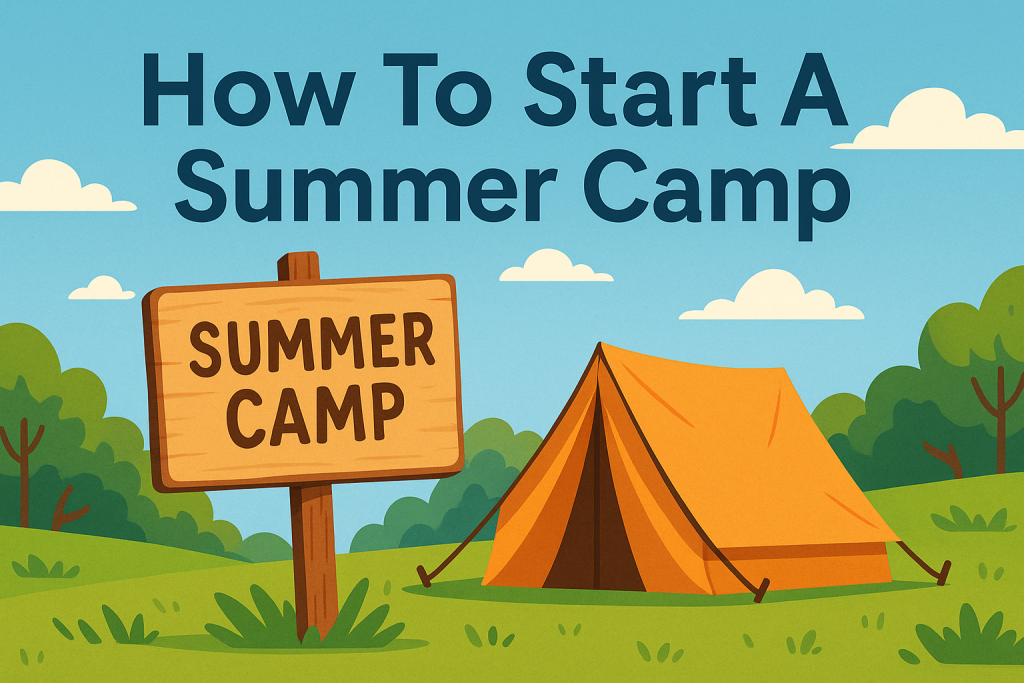Creating engaging youth programs offers entrepreneurs a unique blend of financial opportunity and community impact. With proper planning, these ventures can achieve profit margins of 25% to 40%, according to industry data. Beyond numbers, they provide children with spaces to grow socially, emotionally, and physically through structured activities.
Quality programs help kids develop teamwork skills while exploring nature, arts, or sports. Over 400 accredited organizations in North America demonstrate the growing demand for safe, creative environments where young people thrive. This guide outlines practical steps to transform your vision into reality – whether you imagine daytime adventures or specialty-focused sessions.
New organizers should prepare for both rewards and challenges. Location selection, staff training, and activity design require careful attention. However, the satisfaction of watching participants gain confidence makes the effort worthwhile. Various formats exist to match different resources, from local park-based day programs to overnight wilderness experiences.
Key Takeaways
- Youth programs can generate 25-40% profit margins with strategic planning
- Participants build critical social skills and personal resilience
- Multiple formats accommodate different budgets and locations
- Proper licensing and safety protocols form operational foundations
- Community partnerships enhance program quality and visibility
Understanding the Basics of Summer Camps
From forest adventures to robotics labs, modern camps cater to diverse interests and developmental needs. These environments blend recreation with skill-building, creating spaces where young minds flourish beyond traditional classrooms.
What Defines These Programs?
A summer camp offers structured group experiences during school breaks. Options range from classic outdoor adventures to specialized themes like coding or theater. Ownership models vary widely:
- Privately operated facilities with custom curricula
- Municipal parks departments hosting day programs
- Faith-based organizations integrating values into activities
- Specialized options for neurodiverse participants
Lasting Positive Impacts
These programs strengthen communities by providing safe, supervised spaces. Kids gain communication skills through team challenges and collaborative projects. Outdoor activities promote physical health while reducing screen time.
Parents appreciate reliable childcare solutions, while participants build confidence. Shared experiences around campfires or science experiments often spark lifelong friendships. “The balance between play and learning helps kids absorb skills naturally,” notes a youth development expert.
Seasonal programs also introduce children to new passions. A child hesitant about sports might discover archery talents, while another could develop leadership abilities through group games.
Planning Your Summer Camp Strategy
Effective camp management hinges on precise audience targeting and measurable objectives. A well-defined strategy ensures activities resonate with participants while maintaining financial viability. Let’s explore two foundational elements for building your roadmap.
Identifying Your Target Audience
Successful programs begin by pinpointing who benefits most from your offerings. Analyze local demographics – are families seeking STEM-focused activities or outdoor adventures? Geographic factors matter too. Urban areas might prioritize convenient day programs, while suburban communities could prefer specialty themes.
Consider age-specific needs. Preschoolers thrive with shorter sessions and play-based learning, while teens often seek skill-building opportunities. “Aligning activities with developmental stages boosts engagement,” observes a youth program director. This approach shapes everything from facility layouts to staff hiring criteria.
Setting Clear Goals and Budget Planning
Adopt the SMART framework for objectives. Aiming for 60 campers in Year 1? Specify registration timelines and marketing tactics. Financial plans should detail startup costs like permits ($200-$800) and recurring expenses such as staffing ($15-$25/hour).
Balance revenue streams through tiered pricing or early-bird discounts. Allocate funds for unexpected needs – weather backups or equipment repairs. Tracking progress weekly helps adjust strategies while maintaining quality standards.
How To Start A Summer Camp
A solid blueprint transforms camp visions into operational realities. Clear documentation guides daily decisions while attracting potential investors. This phase combines creativity with financial wisdom to create sustainable youth programs.
Crafting Your Strategic Document
Every successful venture begins with a detailed business plan. Essential components include:
- Core purpose statements aligning activities with community needs
- Competitor analysis identifying local program gaps
- Pricing models balancing accessibility and profitability
Financial projections prove viability to lenders. “Investors want to see realistic enrollment targets and expense breakdowns,” advises a nonprofit funding specialist. Include equipment lists and staffing ratios for complete operational clarity. Learn the crucial steps, including insurance and compliance, in our expert resource on building a medical transport company from the ground up.
Funding Pathways Compared
Multiple financial resources support new initiatives. Consider these options:
| Source | Best For | Typical Amount |
|---|---|---|
| Small Business Loans | Facility upgrades | $10k-$500k |
| Community Grants | Scholarship programs | $2k-$50k |
| Corporate Sponsors | Specialized equipment | Varies |
Seasonal operations require unique cash flow strategies. Maintain six months’ operating expenses for off-season stability. Partner with local businesses for material donations – reduces upfront costs while building community ties.
Entrepreneurs and educators frequently research how to start summer camp programs to provide valuable childhood experiences while building successful seasonal businesses. Understanding how to run a summer camp involves mastering operational logistics, safety protocols, and program development for different age groups.
Marketing considerations include learning how to increase summer camp enrollment through effective outreach strategies and community engagement. Many aspiring camp directors ask how to start a camp to understand the fundamental requirements for launching recreational programs.
Program development involves understanding how to create a summer camp with engaging activities and educational components. Specific formats include learning how to start a day camp for families seeking non-residential options for their children.
Business planning includes how to start your own summer camp and how to start a summer camp program within existing organizations or community centers. Entrepreneurial approaches focus on how to start a summer camp business and starting a summer camp business for sustainable year-round operations.
Age-specific planning includes how to start a summer camp for kids with appropriate activities and safety measures. Broader programming involves how to start a summer program that may extend beyond traditional camp formats.
Operational questions include how to make a summer camp successful through proper planning and execution. Format variations include how to start a summer day camp for families preferring daily drop-off arrangements.
Understanding starting a camp requires comprehensive planning around licensing, insurance, staffing, facilities, and program development to create safe, engaging, and profitable summer experiences for children and families.
Legal and Licensing Requirements
Navigating legal requirements forms the backbone of any successful youth program. Proper documentation protects both organizers and families while creating trustworthy environments. Let’s break down essential steps to establish compliant operations.
Business Registration and Permits
Choosing the right business structure impacts taxes and liability. Options include:
- Sole proprietorship: Simplest setup for small-scale programs
- LLC: Balances personal asset protection with flexibility
- Nonprofit: Ideal for community-focused initiatives
Most states require specific permits like recreational operation licenses or childcare certifications. Day programs serving children under four often need additional health department approvals. “Missing one permit can shut down operations,” warns a licensing consultant.
Ensuring Safety Regulations and Insurance Compliance
Weekly facility inspections and emergency drills keep spaces secure. Mandatory protocols include:
- Water quality tests for pools or lakes
- Food handling certifications for meal programs
- Annual fire marshal sign-offs
Comprehensive insurance bundles typically cover three areas:
| Coverage Type | Protects Against |
|---|---|
| General Liability | Participant injuries |
| Property Insurance | Equipment damage |
| Workers’ Comp | Staff accidents |
Background checks for all employees working with minors aren’t just wise – they’re legally required in 38 states. Regular permit renewals and audit-ready records maintain continuous compliance.
“Proper documentation acts as your safety net during inspections,”
notes a risk management expert.
Developing Engaging Camp Programs and Activities
Crafting memorable experiences requires balancing structure with creative freedom. Successful initiatives blend skill-building opportunities with pure enjoyment, keeping participants eager for each new day.
Designing Age-Appropriate and Fun Activities
Younger campers thrive with short, imaginative sessions like nature scavenger hunts. Pre-teens enjoy collaborative challenges such as obstacle courses or DIY science experiments. For teens, focus on leadership roles in event planning or advanced outdoor adventures.
Mix educational and recreational elements:
- Morning STEM projects using everyday materials
- Afternoon team sports with rotating captains
- Evening talent shows encouraging creative expression
“The best programs let kids grow without realizing they’re learning,” says camp director Mara Simmons. Include adaptable options for different skill levels to boost confidence. For anyone aiming to tap into the growing demand for fast delivery services, this comprehensive resource on launching your own courier service is a must-read.
Structuring Daily Schedules and Special Events
Balance high-energy and downtime:
| Time | Activity Type |
|---|---|
| 9-11 AM | Active outdoor games |
| 1-3 PM | Creative workshops |
| 4 PM | Group reflection sessions |
Theme days like Superhero Saturday or Wilderness Wednesday maintain excitement. Always prepare backup plans – indoor rocketry workshops substitute well for rainy-day cancellations.
Rotate activity leaders weekly to keep perspectives fresh. Track engagement through simple feedback systems – colored wristbands or smiley-face boards work effectively for all ages.
Staffing and Operational Management
Your team shapes every camper’s experience through their skills and dedication. Finding the right people creates safe, engaging environments where children thrive. Let’s explore proven methods to build a reliable team.
Building Your Dream Team
Great counselors blend expertise with enthusiasm. Seek candidates through education programs, local colleges, and youth organizations. Prioritize certifications like CPR, first aid, and activity-specific training for archery or swimming.
Background checks protect everyone. Verify work history and contact references thoroughly. One camp director notes:
“Our 3-step screening process ensures we only hire staff who share our safety-first values.”
Age groups demand different ratios:
| Campers’ Age | Staff Ratio |
|---|---|
| 4-5 years | 1:5 |
| 6-8 years | 1:8 |
| 9+ years | 1:10 |
Keeping Skills Sharp
Orientation week sets expectations. Role-playing scenarios prepare staff for conflicts or emergencies. Monthly workshops update skills – like new games or inclusion strategies.
Reward excellence through bonuses or leadership roles. Happy teams stick around. As one returning counselor says, “We feel valued, so we give our best.”
Daily check-ins and weekly reviews maintain quality. Adjust training based on camper feedback and observed challenges. This approach builds trust with families and fosters repeat enrollments.
Marketing Your Summer Camp and Registration Tips
Connecting families with transformative experiences requires strategic outreach and seamless enrollment processes. A well-crafted digital presence acts as your program’s front door, welcoming parents while showcasing what makes your offerings unique.
Building a User-Friendly Camp Website
Your online hub should answer key questions quickly. Prioritize mobile-friendly designs with clear menus and visible calls-to-action. Essential elements include:
- Activity galleries showing joyful participants
- Staff profiles highlighting certifications
- Safety protocols addressing common concerns
- One-click access to registration forms
Local parent surveys reveal 78% check pricing pages first. Display costs upfront, including sibling discounts or scholarship options. Integrate live chat features for instant support.
Leveraging Social Media and Digital Marketing
Platforms like Instagram and Facebook thrive on authentic storytelling. Share short videos of camp traditions or camper testimonials. One mother notes:
“Seeing daily posts eased our first-time jitters – we knew our child was in good hands.”
Boost visibility with geo-targeted ads during enrollment seasons. Use hashtags like #OutdoorAdventures or #STEMfun to reach niche audiences. Pair online efforts with email newsletters featuring:
- Early-bird registration incentives
- Virtual tour links
- Parent referral bonuses
Simplify sign-ups with auto-filled forms and digital waivers. Track engagement through analytics to refine strategies monthly.
Conclusion
The journey from concept to thriving youth program leaves lasting community legacies. Creating a successful summer camp blends meticulous planning with genuine enthusiasm for child development. Thoughtful preparation lays the groundwork where young minds explore, collaborate, and grow.
Safety protocols and creative staff form the backbone of memorable experiences. Strong community bonds develop when families trust your program’s values and execution. Regular feedback loops help refine activities while maintaining core objectives.
Every registration represents more than revenue – it’s a chance to spark curiosity and build resilience. Stay adaptable to shifting interests without compromising quality. With passion and persistence, your initiative can become a cherished local tradition that shapes futures.







